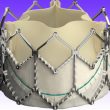Courtesy of Dr. Carlos Fava. The development of new valves for TAVR and the increased experienced of operators have significantly decreased paravalvular leak. However, new bundle Branch block (BBB) and the need for permanent pacemaker (PPM) are still relatively high, and their impact and evolution remain controversial. The study looked at 816 patients, 437...
TAVR in Low-Risk Patients with “Zero” Mortality and “Zero” Stroke
Transcatheter aortic valve replacement (TAVR) is now the standard of care for patients with symptomatic severe aortic stenosis who are at extreme, high, or intermediate risk for surgery. This multicenter, prospective study (Feasibility of Transcatheter Aortic Valve Replacement in Low-Risk Patients With Symptomatic, Severe Aortic Stenosis) included low-risk patients and was approved by the United...
What Should We Use for the Functional Assessment of Coronary Lesions in Severe Aortic Stenosis?
This systematic analysis measured intracoronary pressure in different phases of the cardiac cycle and flow velocity in patients with severe aortic stenosis and coronary artery disease, who were scheduled for transcatheter aortic valve replacement (TAVR). The aim was to determine the impact of aortic stenosis on: 1) flow, at different phases; 2) hyperemic coronary flow;...
TCT 2018 | Mismatch After TAVR According to the TVT Registry
Prosthesis-patient mismatch (i.e. a difference between the size of the implanted prosthetic valve and the patient body size) in patients who undergo surgery is associated with worse outcomes. This may also apply to percutaneous prostheses, although that has not been well-studied yet. This work, presented at TCT 2018 and published simultaneously in JACC, analyzes this problem...
Frailty: What Happens When We Are Too Late in Critical Lower Limb Ischemia
This condition, now “trending” among patients undergoing transcatheter aortic valve replacement (TAVR), has expanded to almost all patients we treat, always with the same outcome: the prognosis is bad, so bad that it might warrant making the difficult decision of not going forward. The association between frailty and bad prognosis is easy to see and...
Urgent/Emergent TAVR: A Valid Option
Courtesy of Dr. Carlos Fava. Aortic stenosis with cardiac failure or cardiogenic shock involves high mortality risk at short term. Surgery in these conditions is often unsafe, which leaves us with valvuloplasty, but only as a bridge to some other procedure, seeing as it is effective only for a short time. Few studies have looked into patients undergoing...
Constrictive Pericarditis After Pericardiocentesis
All interventional cardiologists must be able to perform a pericardiocentesis. Whether we deal with a chronic total occlusion, a supposedly simple coronary angioplasty (we all have witnessed the perforation of a supposedly risk-free coronary artery), or a transcatheter aortic valve replacement (whose rise gave us another significant source of tamponades), we must all be ready...
Diastolic Dysfunction Should Be Considered in TAVR
Aortic stenosis increases afterload creating hypertrophy as a compensation mechanism to maintain minute volume. This leads to left ventricular diastolic dysfunction (LVDD). More than half of patients presenting aortic stenosis have LVDD and myocardial fibrosis, which is a mortality predictor in surgery. At present, there is contradicting evidence in TAVR. The study looked...
Cardiac Damage: Should we start to assess it?
Courtesy of Dr. Carlos Fava. The current recommendation for aortic valve replacement is based on stenosis severity based on valvular criteria (mean transvalvular gradient, peak aortic velocity and valve index area) and the presence of symptoms, in addition to comorbidities, mainly for risk stratification. However, ventricular damage and/or its effect on cardiovascular hemodynamics are not regarded...
Further Evidence on Managing Dysfunctioning Bioprostheses with Balloon-Expandable Prostheses
Early experience with the valve-in-valve technique in the treatment of failed bioprosthetic surgical valves in transcatheter aortic valve replacement (TAVR) has yielded acceptable acute procedural results. This turned the technique into another therapeutic option, one that could even cause the reassessment of the age limit for the surgical implantation of a mechanical or bioprosthesis valve....








